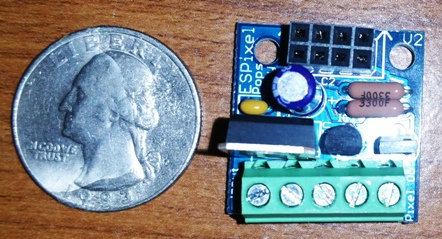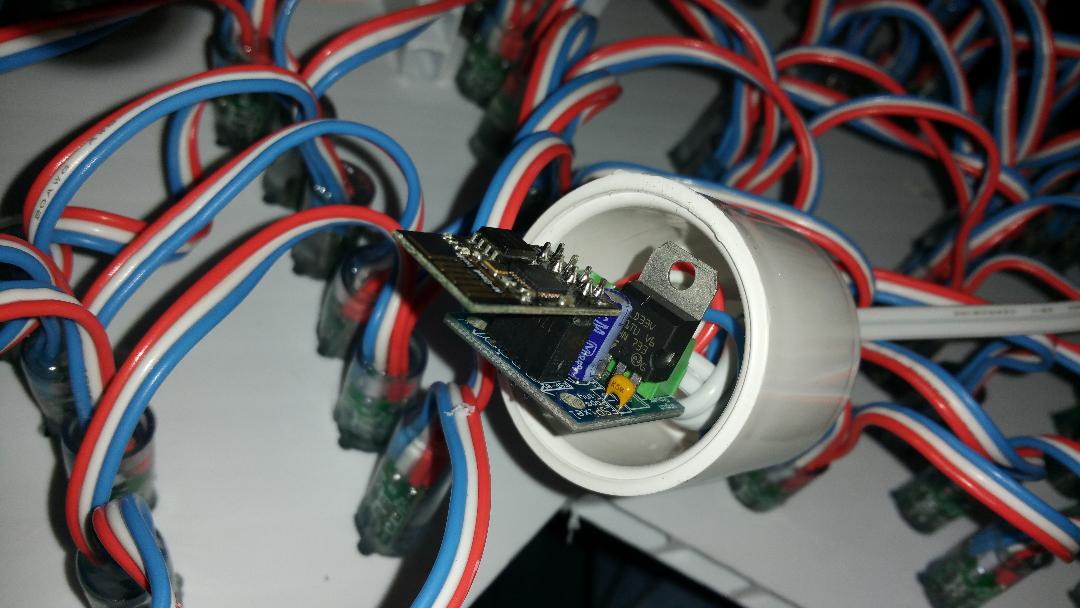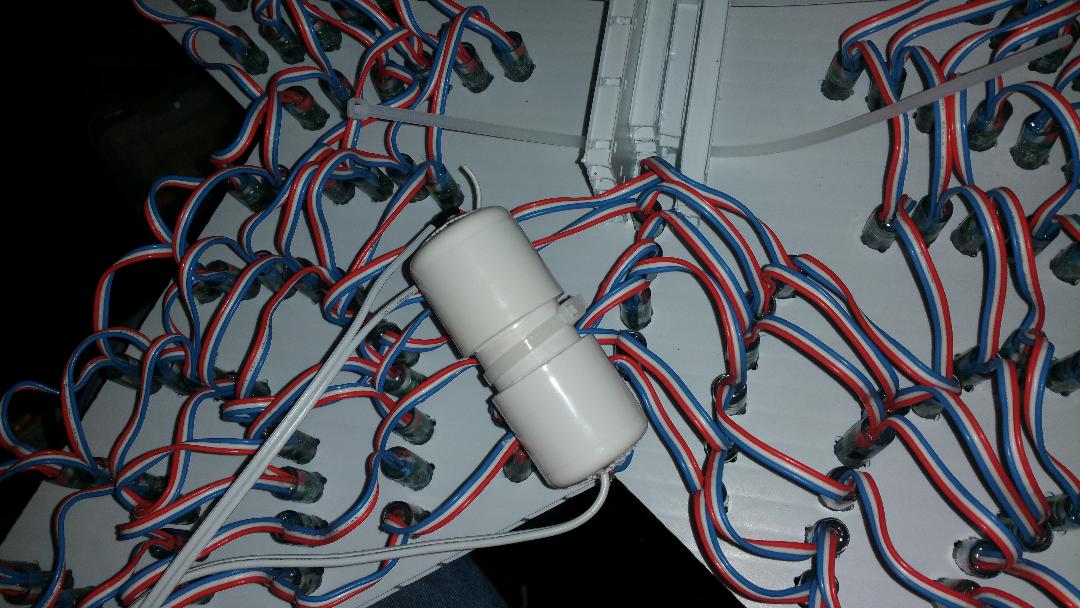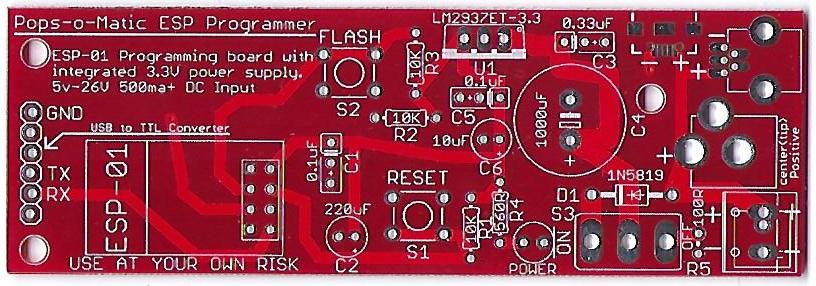Pops-O-Matic ESP Programmer: Difference between revisions
Ukewarrior (talk | contribs) |
Ukewarrior (talk | contribs) |
||
| Line 40: | Line 40: | ||
The BOM contains these generically described parts. The '''SKU at TAYDA electronics''' (www.taydaelectronics.com) is listed as a reference example following the silkscreen part identifier. Part U1 is not sold by TAYDA. | The BOM contains these generically described parts. The '''SKU at TAYDA electronics''' (www.taydaelectronics.com) is listed as a reference example following the silkscreen part identifier. Part U1 is not sold by TAYDA. | ||
A typical total for these parts is about $3-$4. | A typical total for these parts is about $3-$4 not including the ESP-01 module and the TTL converter. | ||
Revision as of 18:25, 7 January 2018
What is the Pops-O-Matic ESP Programmer ?
The Pops-O-Matic is a dedicated programming board for the popular ESP-01 module.
This board was inspired from two articles on allaboutcircuits.com. Specifically:
Voltage Regulator
ESP Flashing Circuit
This programming board supplies both the regulated power and the programming interface for the ESP-01 module.
It specifically isolates the ESP-01 from any of the positive power that may be supplied by your serial-to-TTL programmer.
Only Ground, Transmit, and Receive are connected from the external serial-to-TTL programmer to the Pops-O-Matic.
The purpose of this is twofold.
1. To protect the ESP-01 module from voltages over 3.3V.
2. To provide the ESP-01 with well regulated and steady power during the programming sequence.
Pops-O-Matic Overview
The Pop-O-Matic is designed to be flexible in assembly and use.
It can take a wide variation of power input voltages (5V-16V) and can support up to 5 different power connections.
The board is designed to use any of the following for a power input connection:
1. 5mm Terminal Block
2. 3.5mm Terminal Block
3. Micro USB
4. Mini USB
5. Barrel Terminal Jack
The board has a power ON/OFF switch with a power ON LED indicator.
Order a board
Contact ukewarrior via a PM on DIYC as he often has boards in stock, cheap !
Disclaimers
USE the ESPixel Pops board at Your Own Risk !
The ESPixel Pops board has NO warranty expressed or implied
BOM - Bill of Materials
The BOM contains these generically described parts. The SKU at TAYDA electronics (www.taydaelectronics.com) is listed as a reference example following the silkscreen part identifier. Part U1 is not sold by TAYDA. A typical total for these parts is about $3-$4 not including the ESP-01 module and the TTL converter.
- Input Connectors A-662 - As noted earlier, you have choices for the power input connector. You can populate the board with all the connectors at the same time. The exception to this is that the 3.5mm and 5mm terminal blocks share the same space on the board.
Of course, you can populate it with any combination that suits your fancy, including none at all.
The possible input connectors are: SMD micro USB, through hole mini USB, Terminal Barrel, 3.5mm & 5mm Terminal block.
- S3 A-2001 - Power Switch. SPDT ON-OFF-ON This part is optional. You can short the middle and left holes together to set the board to permanently ON. This SPDT switch has 5mm pin spacing. Most any style will do, both slide and toggle for example.
- D1 A-484 - Diode, specifically 1N5819
- C1 A-214 - MLCC, ceramic Capacitor. 50v, 0.1uF, 2.54mm or 5mm lead spacing.
- C2 A-4506 - Electrolytic Capacitor. 10V, 220uF, 2mm lead spacing, 6mm max diameter.
- C3 A-319 - MLCC, ceramic Capacitor. 50v, 0.33uF, 2.54mm or 5mm lead spacing.
- C4 A-4552 - Electrolytic Capacitor. 25V, 1000uF, 5mm lead spacing, 13mm max diameter.
- C5 A-214 - MLCC, ceramic Capacitor. 50v, 0.1uF, 2.54mm or 5mm lead spacing.
- C6 A-4534 - Electrolytic Capacitor. 25V, 10uF, 2mm lead spacing, 6mm max diameter.
- POWER A-1554 - LED, 5mm, any color.
- R1 A-2203 - 1/4W carbon or metal film resistor. 10K ohm.
- R2 A-2203 - 1/4W carbon or metal film resistor. 10K ohm.
- R3 A-2203 - 1/4W carbon or metal film resistor. 10K ohm.
- R4 A-2282 - 1/4W carbon or metal film resistor. 560 ohm.
- U1 - Voltage Regulator, 3.3V, specifically LM2937ET-3.3, TO-220 package.
- S1 A-5143 - Tactile Switch. 6x6mm through hole.
- S2 A-5143 - Tactile Switch. 6x6mm through hole.
- ESP01 A-1682 - 2x4 femaie pin header. 2.54mm spacing.
- ESP01 - ESP-01 module.
- USB to TTL A-1384 - A 6 pin header. Either vertical or 90 degree mounting. Male or Female to match the pins on your USB-to-TTL Converter.
- USB to TTL converter A-1991 - This is not actually part of the Pops-O-Matic board, but you will need one if you don't already have one.
The two most popular models are known as the FT232RL and CP2102.
The FT232RL by FTDI was the defacto-standard until they released a code version that would brick peoples PC's in an effort to combat Chinese clones.
This angered a lot of the Maker community. The CP2102 then arose as a competitor to FTDI.
Both of these programmers are available all over the internet, ebay and aliexpress.
You can also order one off of TAYDA and is in the example BOM from noted below.
Construction Information
The ESPixel Pops is a pretty easy build. The real trick is deciding how you plan to power your pixels as that will affect what you do with the board wiring.
Depending on your power source, this determines if you should install the 5V regulator or just put a jumper in its place as noted on the the board.
The board has a main voltage regulator that provides 3.3V of power to run the ESP8266 module.
This module does not care if you are running 5V or 12V pixels. So, you can connect 5V or 12V to the board.
The board has a place for a second voltage regulator. This is to accommodate 12V pixels.
This is location IC1 on the board. This is a spot for either a 5V regulator or a wire jumper.
To summarize the population of the voltage regulators and ICs:
The pard labeled: U1 is always installed.
The part labeled: Q1 is always installed.
The part labeled: IC1 is installed if you are running 12V Pixel strings
The part labeled: IC1 is NOT installed if you are running 5V Pixel strings AND you must place a jumper in its place as noted on the board.
Click Here to see the schematic:
Errata

The initial board run has one small error.
There is an unwanted trace on the back of the board that connects the right most pin of part C5 to the ground backplane that covers the bottom of the board.
This unwanted trace should have been placed on the left most pin of C5.
All boards sent out, have had this unwanted trace scraped off the board.
So, the end user doesn't need to do anything to fix this error.
Due to this error, the capacitor for C5 must be mounted using the middle and right most holes only. The left most hole is not connected to anything.
This may cause a problem if your C5 capacitor has 5mm spaced leads. In this case, you would
Pictures of built Pixel Pops boards
user kev in California uses Snapple bottles to build a water resistant enclosure for 5 cents
![]()
Steven Dill uses a Pixel Pops Tiny board enclosed in 1" thin wall PCV to control the coro star on a mega tree.


